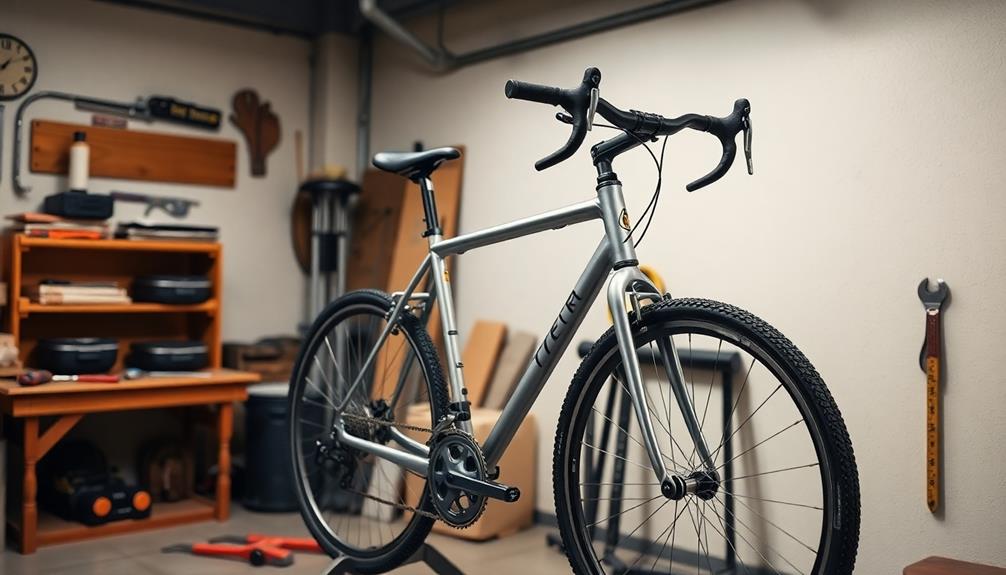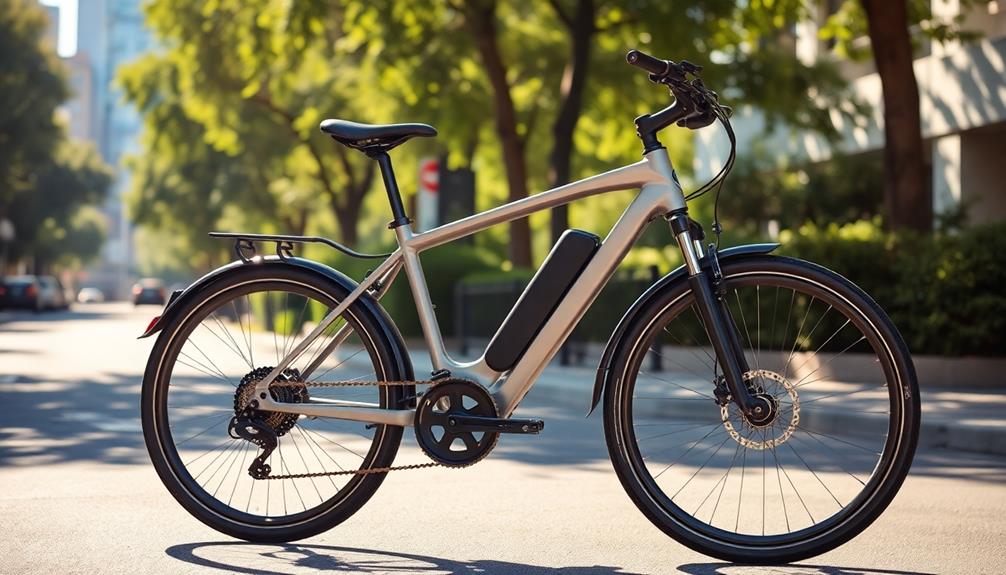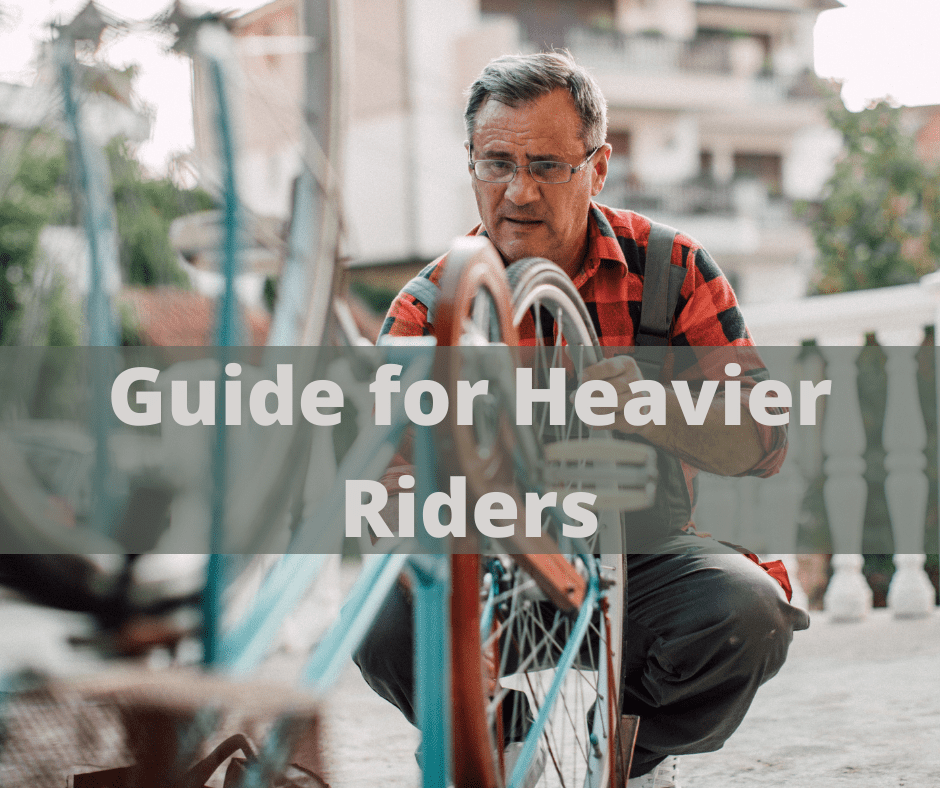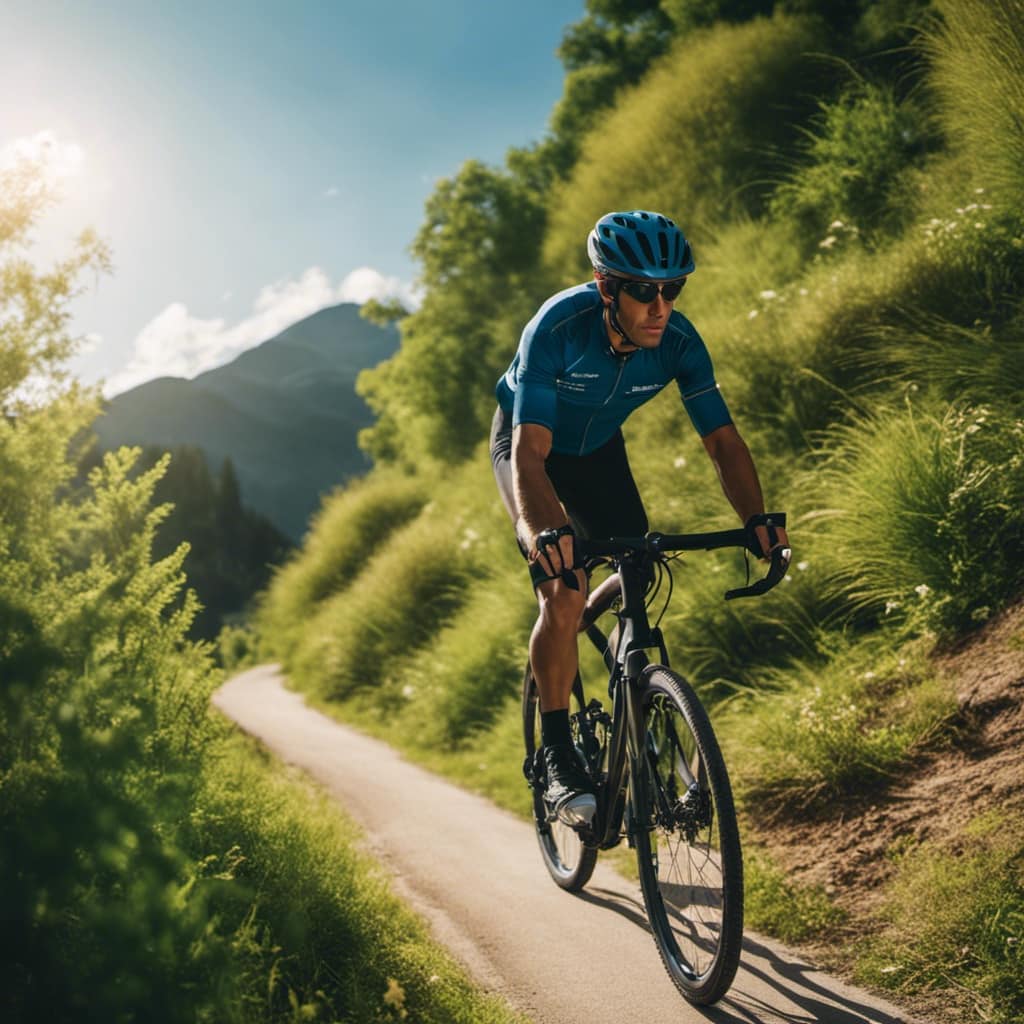To adjust your hybrid bike for the perfect fit, start by measuring your inseam to choose the right frame size. Make certain your saddle height allows for a slight bend in your knee when the pedal is at its lowest point. Position your saddle so your knee aligns over the pedal axle when pedaling backward. For handlebars, keep them at a height that promotes a comfortable posture and guarantees your elbows are slightly bent. Regularly check these adjustments to maintain comfort and performance. There's more to discover about achieving that ideal fit for your riding style.
Key Takeaways
- Measure your inseam length to determine the appropriate frame size and ensure a comfortable standover height of at least 1 inch.
- Adjust saddle height using the heel-on-pedal method to promote efficient pedaling and maintain a slight knee bend at the lowest point.
- Position the saddle so your kneecap aligns over the pedal axle during the downstroke for optimal fore/aft positioning.
- Ensure handlebar height is slightly below saddle height to maintain a relaxed upper body posture and prevent discomfort.
- Regularly reassess and adjust saddle and handlebar positions to accommodate changes in strength, flexibility, and riding style.
Importance of Proper Fit
When it comes to cycling, a proper bike fit is vital for your comfort and overall enjoyment. Without it, you might find yourself dealing with aches and pains that can ruin your rides.
Bike fitting is about more than just adjusting the saddle height; it's about aligning your entire riding position with your body dimensions. Just like how the role of contrast ratio in projector image quality enhances viewing experiences, a proper bike fit enhances your cycling performance.
An ideal fit considers your height, flexibility, and riding style, ensuring that your bike accommodates you perfectly. When your saddle height is correct, you can pedal efficiently, reducing the risk of injuries like knee pain and lower back discomfort.
A well-fitted bike allows for comfortable riding, encouraging you to spend more time on the road without fatigue. Adjustments to handlebars and saddle position are also essential. These changes enhance comfort and help you maintain a suitable riding posture, minimizing stress on your body.
Choosing the Right Frame Size

Finding the right frame size for your hybrid bike is just as important as achieving a proper fit. Start by measuring your inseam length, as this will help you determine the appropriate frame size. Ideally, your standover height should allow for at least 1 inch of clearance with a straight top tube or 2 inches with a sloping top tube. This guarantees comfort and safety while riding.
Additionally, consider how you might adjust your bike's performance through GMC tuning if you're seeking to optimize your riding experience further.
Next, refer to the manufacturer's size chart since hybrid bikes generally come in small, medium, and large sizes, which can vary between brands. It's vital to test ride different sizes to assess comfort, as personal preferences and riding style play a significant role in choosing the ideal frame size.
Pay attention to the effective top tube length (ETT), as it affects your upper body fit. If you're shorter, a shorter ETT may provide a more comfortable reach.
Adjusting Saddle Height
When adjusting your saddle height, it's essential to find the ideal position for efficient pedaling. A well-fitted bike can greatly improve your riding experience, much like how understanding your budgeting strategies can enhance financial health.
Start by using the heel on pedal method to guarantee your leg is fully extended with a slight knee bend at the lowest point. This alignment not only enhances your comfort but also helps prevent knee strain during your rides.
Optimal Saddle Height Techniques
Achieving the ideal saddle height is essential for a comfortable and efficient ride on your hybrid bike. To find your best saddle height, start by ensuring your leg is slightly bent at the knee when the pedal is at its lowest point. This position allows for efficient power transfer and minimizes the risk of injury.
Additionally, consider how an electric bike conversion kit, such as the PEXMOR Electric Bike Conversion Kit, can enhance your riding experience by providing a boost during climbs and longer rides.
A popular method for setting saddle height is the "heel on pedal" technique, where you place your heel on the pedal with the pedal at the bottom of its stroke. Make sure your leg is fully extended without locking your knee.
For a more precise measurement, consider using the 109% method: measure your inseam in centimeters and multiply by 1.09 to find the ideal saddle height from the center of the bottom bracket.
Once you've found your best saddle height, mark it on the seat post with tape or a marker for easy reference during future adjustments. Regularly check and adjust as needed, especially if you experience discomfort or fatigue during rides, as these can indicate your saddle is either too high or too low.
Proper adjustments lead to a more enjoyable cycling experience!
Heel on Pedal Method
To nail down the perfect saddle height, the heel on pedal method is a reliable technique that many cyclists swear by. Start by sitting on your bike and placing your heel on the pedal. As you push the pedal to its lowest point, your leg should be fully extended. This positioning helps you determine the ideal saddle height for effective riding.
It's crucial to guarantee that you're comfortable while cycling, as comfort can enhance your overall experience and performance, much like how supporting a partner ready for parenthood can foster a positive environment during a family change.
Here are a few tips to keep in mind:
- Look for a slight bend in your knee when your foot is positioned normally on the pedal.
- If you notice rocking hips while pedaling, your saddle might be too high, so lower it for better comfort and biomechanics.
- For precise adjustments, mark the ideal saddle height on the seat post with tape or a marker for easy reference.
- Regularly check your saddle height, especially after maintenance or if you feel discomfort; even minor adjustments can greatly impact your riding efficiency.
Knee Alignment Considerations
Saddle height not only affects comfort but also plays a significant role in knee alignment during your ride. To achieve the ideal knee angle of approximately 30 degrees at the bottom of the pedal stroke, it's essential to adjust your saddle height correctly.
The heel-on-pedal method is a practical approach; when your heel rests on the pedal, your leg should be fully extended without locking your knee. Additionally, confirming a proper fit can prevent discomfort during long rides, much like how top rated vacuums are designed for peak performance.
A good starting point is to set your saddle height to about 109% of your inseam length. From there, you can make further adjustments based on your personal comfort. Confirm your knee aligns directly above the pedal spindle during the downstroke. This alignment is critical for efficient power transfer and preventing injuries.
Regularly check your saddle height, especially after significant riding changes or if you experience discomfort. Even minor adjustments can make a big difference in knee alignment and overall cycling performance.
Fore/Aft Saddle Positioning

To find the right fore/aft saddle position, start by aligning your kneecap over the pedal axle while pedaling backward. This positioning is essential for maintaining proper body mechanics and can help prevent discomfort during long rides, similar to how air purifier maintenance can enhance indoor air quality.
Consider your height, as taller riders might need their saddle slightly behind the crankarm for comfort, while shorter riders often benefit from having it directly over the crankarm.
Adjusting the saddle can enhance your comfort and efficiency, especially on longer rides.
Knee Alignment Technique
Getting your knee alignment right is vital for a comfortable and efficient ride on your hybrid bike. Proper fore/aft saddle positioning plays a significant role in achieving this alignment.
To guarantee your knee aligns vertically with the pedal axle, sit on your bike and pedal backwards. A plumb line from the center of your kneecap should drop directly over the pedal spindle when your foot is at the 3 o'clock position. Using the right technique can make a big difference, much like how hydrocolloid technology promotes healing in acne patches.
Here are some tips to help you find the perfect fit:
- Taller riders may prefer their saddle 1-2 cm behind the crankarm for better comfort during long rides.
- Shorter riders or sprinters might benefit from having their knee directly over the crankarm.
- An incorrect fore/aft position can lead to discomfort and strain on your knees.
- Make adjustments gradually and test your setup over short rides to guarantee efficiency.
Rider Height Considerations
Finding the right fore/aft saddle position is essential for maximizing your comfort and efficiency on a hybrid bike. To achieve this, align your knee with the pedal axle when the pedal is in the 3 o'clock position. You can use a plumb line from your kneecap to the crankarm as a helpful guide.
Taller riders often prefer their saddle positioned 1-2 cm behind the crankarm for long-distance comfort, while shorter riders or sprinters might choose to place it directly over the crankarm. Additionally, just like selecting the right home security system, personal preferences and specific needs can influence your ideal saddle position. Consider factors influencing costs when evaluating your bike setup.
From my personal experience, pedaling backwards while seated can help you find your ideal fore/aft position, ensuring effective power transfer during your rides.
Remember, the saddle should be centered on the rails over the seat post to avoid lateral movement and maintain stability while pedaling.
Adjustments can be made to the fore/aft saddle position, which can greatly impact your riding efficiency and overall comfort. Proper positioning reduces the risk of knee strain and enhances your performance, making every ride more enjoyable.
Take the time to experiment with these adjustments to find what works best for you.
Adjusting for Comfort
Adjusting the fore/aft saddle position on your hybrid bike plays a significant role in your overall comfort during rides. To get it just right, sit on your bike and pedal backwards until you're comfortably seated. A plumb line from your kneecap should align with the pedal axle for ideal positioning.
It's important to reflect on how Montessori toys can promote hands-on learning and exploration, just as finding the correct saddle position allows you to engage fully in your cycling experience.
Reflect on these tips when making adjustments:
- Taller riders may find it better to position the saddle 1-2 cm behind the crankarm for long-distance comfort.
- Shorter riders or sprinters might prefer the saddle directly over the crankarm for efficiency.
- Always make sure the saddle is centered on the rails to maintain balance and comfort while riding.
- Regularly reassess your saddle position after long rides, as your comfort preferences can change based on your riding style and distance.
Finding the right saddle position not only enhances your fit but also alleviates knee strain and promotes efficient power transfer.
Taking the time to fine-tune these adjustments will lead to a more enjoyable and comfortable riding experience.
Handlebar Height Adjustments

When it comes to ensuring a comfortable ride on your hybrid bike, handlebar height plays a significant role. To achieve the perfect fit, start by placing your bike on a level surface and comparing the handlebar height to the saddle height. Aim for a position that promotes a relaxed riding posture.
If you find that the handlebars are too low, you can make adjustments using spacers or a different stem to raise them. A higher handlebar height is often preferred for hybrid bikes, encouraging an upright upper body position that alleviates discomfort in the neck and lower back.
Once you've made adjustments, sit on your bike and check for a slight bend in your elbows. This indicates a comfortable reach and grip, important for both comfort and performance.
Don't forget to regularly reassess handlebar height after your rides, as your strength and flexibility may change over time. Maintaining proper spinal alignment will enhance your riding experience, so stay proactive about these adjustments.
Finding the right handlebar height is essential for maximizing your ride's comfort and overall performance.
Handlebar Reach and Comfort

A proper handlebar reach is essential for maintaining comfort and control while you ride your hybrid bike. When you achieve the ideal reach, you'll experience a comfortable elbow bend that promotes better weight distribution, reducing strain on your neck, shoulders, and back.
To find your perfect position, use a plumb line from your nose to the handlebars while seated—this should ideally fall within a few centimeters.
Here are some tips to enhance your handlebar reach and comfort:
- Adjust the handlebar height to align with or slightly below saddle height.
- Consider wider handlebars for an open-chested riding position, improving airflow.
- Regularly assess your handlebar reach to boost riding efficiency.
- Confirm your grip allows for a relaxed, natural riding position.
Making these adjustments not only improves comfort but also enhances your riding efficiency, especially during longer sessions.
With the right handlebar reach, you'll enjoy a more enjoyable ride, free from unnecessary fatigue. So take the time to fine-tune your hybrid bike's setup, and you'll notice the difference on your next adventure!
Standover Height Considerations

Standover height plays a vital role in your safety and comfort while riding a hybrid bike. It's important to have a comfortable straddle position, which means you should be able to stand over the top tube of your bike frame without feeling restricted.
While hybrid bikes may not require strict adherence to standover height guidelines like road or mountain bikes, having a minimum clearance of about 1 to 2 inches is still necessary for rider confidence and ease of dismounting.
To find the right standover height, straddle the bike with flat feet and make sure you feel relaxed and balanced. If you can comfortably stand over the top tube, you're on the right track.
Remember, effective top tube (ETT) length combined with proper standover height greatly impacts your overall fit. This balance helps make sure you maintain a natural upper body position during rides, reducing strain and enhancing your cycling experience.
If you find yourself too close to the top tube or feel cramped, consider adjusting the bike's frame size or saddle height.
Ultimately, achieving the right standover height helps you ride with confidence and comfort.
Specialized Fitting for Women and Kids

For ideal comfort and performance, specialized fitting for women and kids is vital when selecting a hybrid bike. Women's bikes are designed with narrower handlebars and shorter top tubes, accommodating lower shoulder widths and longer leg proportions. This guarantees you can fit your bike perfectly and ride comfortably.
When fitting kids' bikes, safety is essential. Here are some tips to keep in mind:
- Guarantee a standover height of 2-4 inches for safety and confidence.
- Adjust the saddle height so there's a slight bend in the knee at the pedal's lowest position.
- Choose a women's-specific saddle that features a wider rear and a cut-out for added comfort.
- Set the handlebar height to promote an upright riding position, reducing strain on the back and neck.
These adjustments not only enhance comfort but also improve control for both women and kids.
Proper fitting encourages a more enjoyable riding experience, making it easier to explore new paths and stay active. By focusing on these key elements, you're setting the stage for countless adventures on your hybrid bike!
Regular Maintenance of Fit

Maintaining the fit of your hybrid bike is vital for peak performance and comfort. Start by regularly checking and adjusting the saddle height to guarantee there's a slight bend in your knee at the bottom of the pedal stroke. This adjustment enhances your pedaling efficiency and comfort.
Next, monitor your handlebar height and reach to keep a neutral spine position, which helps alleviate discomfort in your neck and back during rides.
Don't forget to inspect and adjust the saddle angle—aim for a tilt of 2-3 degrees based on your personal comfort preferences. This small change can considerably impact your overall riding experience and pressure distribution.
Periodically reassess the fore/aft saddle position to confirm proper knee alignment over the pedal spindle, as this is vital for reducing strain and enhancing power transfer.
To stay organized, keep a record of the adjustments you make and mark your ideal settings on the bike. This way, you can quickly re-establish your fit after any maintenance or changes in your riding style, guaranteeing you enjoy every ride without discomfort.
Regular maintenance will keep your bike fit dialed in for the best experience achievable.
Frequently Asked Questions
How Should You Fit on a Hybrid Bike?
To fit on a hybrid bike, straddle the frame for clearance, adjust the saddle height for a slight knee bend, position the saddle correctly, and guarantee handlebars align for comfort. You'll feel more in control.
How to Sit Properly on a Hybrid Bike?
Sitting securely, settle your sit bones on the saddle. Keep your elbows slightly bent, hands relaxed, and feet centered on the pedals. Straighten your back and engage your core for comfort and control during rides.
How Do I Adjust My Bike to Fit Me?
To adjust your bike for a perfect fit, start with saddle height, then position it fore/aft. Check saddle tilt, adjust handlebar height, and make certain your reach to the handlebars promotes comfort and proper posture.
How High Should My Seat Be on My Hybrid Bike?
Did you know that a proper seat height can boost your pedaling efficiency by up to 30%? For your hybrid bike, adjust your seat so you've got a slight knee bend at the lowest pedal position.
Conclusion
Getting your hybrid bike to fit just right is essential for comfort and performance. Did you know that a proper fit can increase your cycling efficiency by up to 30%? By taking the time to adjust the saddle height, handlebar position, and standover height, you'll not only enjoy your rides more but also reduce the risk of injury. Remember, a well-fitted bike makes every journey more enjoyable, so don't skip those vital adjustments!









